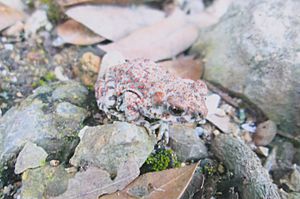Red-spotted toad facts for kids
Quick facts for kids Red-spotted toad |
|
|---|---|
 |
|
| Conservation status | |
| Scientific classification | |
| Synonyms | |
|
Bufo punctatus Baird and Girard, 1852 |
The red-spotted toad (Anaxyrus punctatus) is a small, interesting toad. You can find it in the southwestern parts of the United States and northwestern Mexico. It used to be called Bufo punctatus. This toad is part of the toad family called Bufonidae.
Contents
About the Red-Spotted Toad
This toad is quite small, usually growing to be about 3.7 to 7.5 centimeters long. That's like the length of your thumb to your palm! It has a flat head and body. Its back, also called its dorsum, can be light gray, olive, or reddish-brown. It has special reddish or orange skin glands on its back.
The toad's belly, or venter, is usually whitish or light yellow. Sometimes it has faint dark spots. It also has round glands behind its eyes called parotoid glands. These glands can release a mild substance if the toad feels threatened. The toad's nose is pointed.
Young Toads and Special Features
Young red-spotted toads look a lot like the adults. However, their bellies might have more noticeable spots. The bottoms of their feet are also yellow.
Male red-spotted toads have a darker throat. During the time they look for mates, they grow special rough spots on their thumbs. These are called nuptial pads and help them hold onto the female during breeding.
Sometimes, red-spotted toads can breed with other toad types, like the western toad (Anaxyrus boreas). This creates a mix of the two species, called a hybrid. These toads are usually calm and easy to handle. They don't often release much of their skin gland liquid.
Where Red-Spotted Toads Live
This toad lives in the southwestern United States and northwestern Mexico. You can find them a lot in Baja California. They especially like areas with rocky streams and riverbeds. These places are often very dry, known as arid or semi-arid regions.
Habitat and Water Needs
In areas near the coast, they are found in specific spots. But in the deserts, they are spread out widely. In dry places, these toads need temporary pools of water or even puddles from rain to lay their eggs.
Their eggs hatch very quickly, in about three days. The tadpoles can change into small toads in just 6 to 8 weeks. This fast growth helps them use the temporary water before it dries up. These short-lived water bodies are called ephemeral.
During dry times, red-spotted toads hide in burrows, under rocks, or beneath moist plants. When it rains, they suddenly become very active. Many toads will come out at once to enjoy the wet conditions.
See also
 In Spanish: Sapo de puntos rojos para niños
In Spanish: Sapo de puntos rojos para niños



